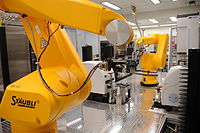
Photo from wikipedia
BackgroundThe halophilic bacterium Chromohalobacter salexigens is a natural producer of ectoines, compatible solutes with current and potential biotechnological applications. As production of ectoines is an osmoregulated process that draws away… Click to show full abstract
BackgroundThe halophilic bacterium Chromohalobacter salexigens is a natural producer of ectoines, compatible solutes with current and potential biotechnological applications. As production of ectoines is an osmoregulated process that draws away TCA intermediates, bacterial metabolism needs to be adapted to cope with salinity changes. To explore and use C. salexigens as cell factory for ectoine(s) production, a comprehensive knowledge at the systems level of its metabolism is essential. For this purpose, the construction of a robust and high-quality genome-based metabolic model of C. salexigens was approached.ResultsWe generated and validated a high quality genome-based C. salexigens metabolic model (iFP764). This comprised an exhaustive reconstruction process based on experimental information, analysis of genome sequence, manual re-annotation of metabolic genes, and in-depth refinement. The model included three compartments (periplasmic, cytoplasmic and external medium), and two salinity-specific biomass compositions, partially based on experimental results from C. salexigens. Using previous metabolic data as constraints, the metabolic model allowed us to simulate and analyse the metabolic osmoadaptation of C. salexigens under conditions for low and high production of ectoines. The iFP764 model was able to reproduce the major metabolic features of C. salexigens. Flux Balance Analysis (FBA) and Monte Carlo Random sampling analysis showed salinity-specific essential metabolic genes and different distribution of fluxes and variation in the patterns of correlation of reaction sets belonging to central C and N metabolism, in response to salinity. Some of them were related to bioenergetics or production of reducing equivalents, and probably related to demand for ectoines. Ectoines metabolic reactions were distributed according to its correlation in four modules. Interestingly, the four modules were independent both at low and high salinity conditions, as they did not correlate to each other, and they were not correlated with other subsystems.ConclusionsOur validated model is one of the most complete curated networks of halophilic bacteria. It is a powerful tool to simulate and explore C. salexigens metabolism at low and high salinity conditions, driving to low and high production of ectoines. In addition, it can be useful to optimize the metabolism of other halophilic bacteria for metabolite production.
Journal Title: Microbial Cell Factories
Year Published: 2018
Link to full text (if available)
Share on Social Media: Sign Up to like & get
recommendations!